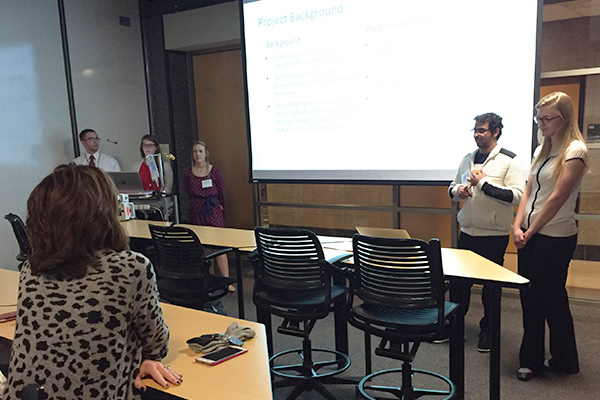Dayton Engineer

Growing Innovation Center Studies Urban Agriculture and Many Other Challenges
By Kelly Garrow
A total of 65 teams presented the results of their research and design ideas to sponsors from government, industry, healthcare and units throughout the University.
The record setting enrollments the School of Engineering saw four and five years ago are now producing record numbers of seniors participating in the Symposium. Innovation Center Director Rebecca Blust and Libby Lopresti, administrative assistant, orchestrate an intense couple of weeks leading up to the two full days of presentations made on the hour to small groups of sponsors, faculty, staff and fellow students.
Many of the presentations are proprietary, but each year there are challenges that can be shared, many of which have a strong component of community benefit. There are the two teams trying to design an IV system for chemo patients that will eliminate life threatening bubbles in the tubing. Those bubbles slow down chemotherapy infusions that are already agonizingly long.
Other groups are working on assistive writing devices, all-terrain wheelchair wheels, solar light arrays for the campus RecPlex and many additional engineering problems.
Two groups took on the challenge of researching urban farming, with a goal of addressing “food deserts” in the city and providing fresh produce on a year-round basis.
Matt Dieringer, an engineer by training, is president of Dieringer Development, a downtown real estate development firm that sponsored one of the teams. Dieringer became interested in the viability of commercial indoor agriculture through his work with the Urban Renewal Farm, a budding Dayton charity currently organizing to become a non-profit.
“I have a passion for growing better food for people to eat,” Dieringer said. “With techniques like aeroponics, we can grow a better quality product and have it available on a consistent basis. Plus, these techniques use 98 percent less water than growing in soil and produce harvests up to three times faster.”
Dieringer noted that the engineering students were enthusiastic about the project, brought a different perspective to the work and saved him “lots of man hours.”
“The Innovation Center is a great opportunity to have a team dive in and do in-depth research and development,” he said. “The students did a great job and were very professional in their manner and presentation.”
Dieringer plans to continue the work next semester by sponsoring a team to develop a small prototype growing center that is scalable and uses techniques and products researched this semester.
That suits team member Ryan McAninch, a senior electrical engineering major. “I hope this concept continues and eventually makes it to homes and grocery stores. I would be excited to see indoor home units, affordable for the everyday person, or grocery stores wheeling out tower units with that day’s fresh ready-to-harvest produce,” McAninch said. “I would even like to see this concept used by the ETHOS programs and taken to places where traditional soil farming is not possible.”

